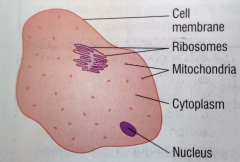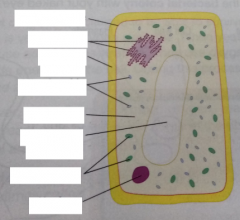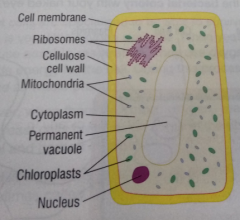![]()
![]()
![]()
Use LEFT and RIGHT arrow keys to navigate between flashcards;
Use UP and DOWN arrow keys to flip the card;
H to show hint;
A reads text to speech;
39 Cards in this Set
- Front
- Back
|
Name the 5 parts of an animal cell.
|
Nucleus, cytoplasm, cell membrane, mitochondria, ribosomes.
|
|

|

|
|
|
What is the function of the nucleus?
|
The nucleus controls all the activities of the cell. It contains the genes of the chromosomes that carry the instructions for making proteins needed to build new cells or new organisms.
|
|
|
What is the function of the cytoplasm?
|
The cytoplasm is a liquid gel in which most of the chemical reactions needed for life take place, for example the first stages of cellular respiration.
|
|
|
What is the function of the cell membrane?
|
The cell membrane controls the passage of substances such as glucose and mineral ions into the cell. It also controls the movement of substances such as urea or hormones out of the cell.
|
|
|
What is the function of mitochondria?
|
Mitochondria are structures in the cytoplasm where oxygen is used and most of the energy is released during respiration.
|
|
|
What is the function of ribosomes?
|
Ribosomes are where protein synthesis takes place, making all the proteins needed in the cell.
|
|
|
Name the three additional parts that may be in a plant cell or algal cell.
|
Cell wall, chloroplasts, permanent vacuole.
|
|

|

|
|
|
What is the function of the cell wall?
|
The cell wall is made from cellulose that strengthens the cell and gives it support.
|
|
|
What is the function of chloroplasts?
|
Chloroplasts are found in all the green parts of the plant. They contain chlorophyll, which absorbs light energy to make food by photosynthesis.
|
|
|
What is the function of a permanent vacuole?
|
A permanent vacuole is the space in the cytoplasm filled with cell sap. This is important for keeping the cells rigid to support the plant.
|
|

|

|
|
|
What is the function of plasmids?
|
Plasmids carry extra genetic information. Plasmids are used by scientists in the process of genetic engineering.
|
|
|
Why are bacteria useful?
|
We use them to make food like yoghurt and cheese. Others are used in sewage treatment and to make medicines. They are vital is decomposers in food chains and webs, and in natural cycles such as the carbon and nitrogen cycles. They are also an important part of a healthy gut.
|
|
|
How do yeasts reproduce?
|
Asexual budding.
|
|
|
What is asexual budding?
|
The process in which a new yeast cell grows out from the original cell to form a separate yeast organism.
|
|
|
What is fermentation?
|
The anaerobic respiration of yeast.
|
|
|
When yeast cells use anaerobic respiration, breaking down sugar in the absence of oxygen, what do they produce?
|
Ethanol and carbon dioxide.
|
|
|
What is yeast useful?
|
Yeast is important in the production of antibiotics such as penicillin, as decomposersin food chains and webs, and in the carbon cycle. It can be used to make alcohol and bread.
|
|
|
What problems does yeast cause?
|
Yeast breaks down and decomposes food people are storing.
|
|
|
How are fat cells adapted?
|
They have a small amount of cytoplasm and large amounts of fat.
They have few mitochondria as the cells need very little energy. They can expand as they fill up with fat. |
|
|
How are cone cells adapted?
|
The outer segment contains a visual pigment that changes chemically in coloured light. It needs energy to change back.
The middle segment is full of mitochondria to reform the visual pigment, letting you see continually in colour. The final part is a synapse that connects to the optic nerve. When the visual pigment changes, a nerve impulse is triggered. |
|
|
How are root hair cells adapted?
|
They increase the surface area for water to move into the cell.
They have a permanent vacuole that speeds up the movement of water by osmosis from the soil across the root hair cells. |
|
|
How are sperm cells adapted?
|
A long tail helps the sperm move towards the egg.
The middle section is full of mitochondria for the tail to work. The acrosome stores digestive enzymes for breaking down the outer layers of the egg. A large nucleus contains the genetic information to be passed on. |
|
|
What is diffusion?
|
The spreading out of particles in a gas, or any substance in a solution (a solute) which results in a net movementof particles. The movement is from an area of high concentration to low concentration. Also known as down a concentration gradient.
|
|
|
What affects the rate of diffusion?
|
The greater the difference in concentration, the faster the rate of diffusion.
An increase in temperature increases the rate of diffusion. |
|
|
How is osmosis different from diffusion?
|
Water moves from a dilute solution to a concentrated solution.
|
|
|
If the concentration of solutes in the solution outside the cell is the same as the concentration inside the cell, the solution is ... to the cell.
|
isotonic, animal cells are normal and plant cells are flaccid
|
|
|
If the concentration of solutes in the solution outside the cell is higher than the concentration inside the cell, the solution is ... to the cell.
|
hypertonic, animal cells will shrivel and plant cells become plasmolysed
|
|
|
If the concentration of solutes in the solution outside the cell is lower than the concentration inside the cell, the solution is ... to the cell.
|
hypotonic, animal cells will burst and plant cells will be turgid/normal
|
|
|
What is useful about active transport? What is a downside?
|
It can move particles against the concentration gradient. It requires energy.
|
|
|
What cells carry out lots of active transport?
|
Root hair cells and cells in your gut. They both have many mitochondria.
|
|
|
As organisms get bigger, their surface area to volume ratio gets ... ?
|
Smaller.
|
|
|
What are the disadvantages of being a big organism?
|
Gases and food molecules can no longer reach every cell inside the organism by simple diffusion.
Metabolic waste cannot be removed fast enough to avoid poisoning the cells. |
|
|
What adaptations make the process of exchange more efficient?
|
Having large surface area provides a bigger area for exchange to take place.
Being thin provides a short diffusion path. Having an efficient blood supply (in animals) moves the diffusing substances away and maintains a concentration gradient. Being ventilated (in animals) to make gaseous exchange more efficient by maintaining a steep concentration gradient. |
|
|
What happens in the small intestine?
|
Digested food molecules move into the bloodstream to reach your cells.
|
|
|
What gets diffused in the small intestine and how is it adapted for diffusion?
|
Digested food molecules get diffused into the bloodstream. This is because there is a much higher concentration of food molecules in the gut than in the bloodstream.
The lining of the small intestine is folded into villi to increase the rate of diffusion. Each villus is covered by microvilli for the same reason. The lining of the small intestine has a good blood supply to carry away the digested food molecules as soon as they are diffused to maintain a steep concentration gradient. The villi have thin walls so there is a short distance across which diffusion takes place. |
|
|
What gets transported via active transport in the small intestine?
|
You will eventually have more dissolved food molecules in your blood than your digestive system so active transport moves glucose and other dissolved food molecules into the bloodstream.
|

